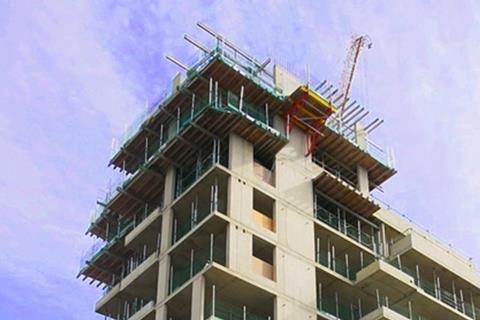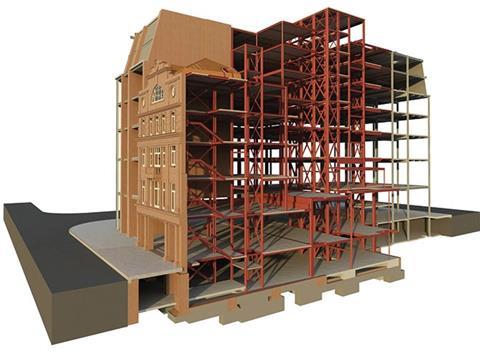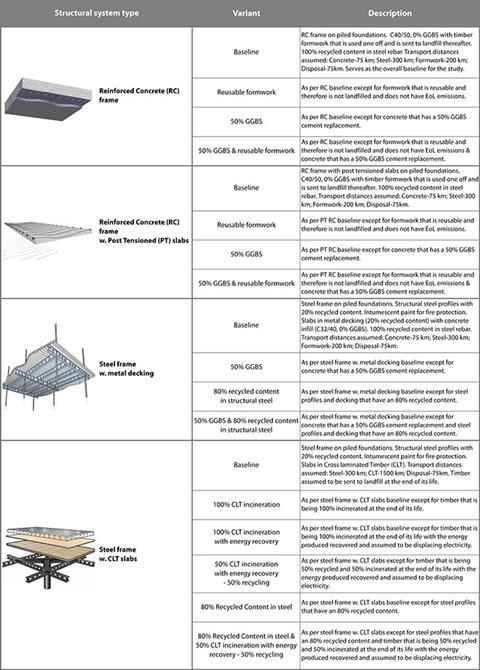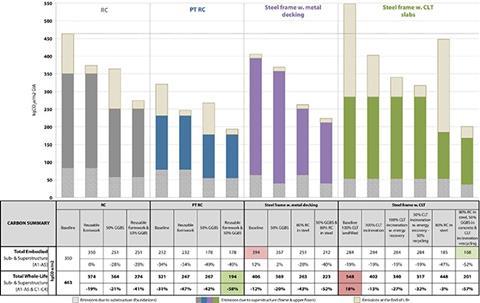The embodied carbon of a non-domestic development can be altered to a significant degree depending on the choice of materials used in its structural system. Athina Papakosta of Sturgis Carbon Profiling looks at the emissions of the most popular materials used

01 / Introduction
The selection of structural systems is key to non-domestic developments from an architectural, stability and cost perspective, but is also influential on the embodied carbon side. The structure constitutes the backbone of the building and is the longest serving set of elements. Given all of the above, getting it right in all aspects is essential. The focus of this article is on the carbon emissions front, looking at the impact of different structural systems on whole-life carbon. A range of typical structural forms featuring the three main structural constituent materials – concrete, steel and timber – have been comparatively examined in terms of embodied carbon and cost. Beyond that, the substantial role of careful design and material specification in the overall carbon emissions as well as end of life (EoL) scenarios and the concepts of future-proofing, designing for re-use and the recyclability of structural components have been explored.
Methodology
The carbon figures presented in this study have been calculated based on the respective British standard BS EN 15978, which is derived from the work of the EU CEN/TC 350 – sustainability of construction works technical committee. All life cycle stages defined in the standard have been considered; from material extraction and product manufacture [A1-A3], transport to site and construction process [A4-A5] to the in-use and end-of-life stage [B1-B6] and [C1-C4]. With respect to the emissions associated with the structural systems over the service life of the building, it has been assumed that due to the very nature of the structural elements these will not require any maintenance, repair or replacement under normal circumstances, nor do they produce any operational emissions. As far as the end of life (EoL) carbon is concerned, the deconstruction, the transport and the actual disposal of elements have been considered. The carbon emissions arising from the waste processing (i.e. incineration [C3]) or the disposal (i.e. landfilling [C4]) of organic waste in particular, are substantial and are therefore shown as individual entities to provide a complete whole-life picture. Any benefits beyond the end of the life of the timber [Module D], in this case the energy recovery from incineration, have been quantified in separate scenarios. The additional benefit of the carbon sequestered and locked in the timber was not included within the frame of this study.
Subsequently, the carbon emissions attributed to the different structures in this article represent embodied carbon at practical completion [A1-A5], unless stated otherwise for systems featuring timber. The material quantity and cost data used derive from projects that Sturgis Carbon Profiling (SCP) has worked on.
02 / Material elements of structural systems
The three main materials used for structural purposes are concrete, steel and timber. Simple, low-rise housing schemes often feature load-bearing brick and block masonry but these are deemed outside of the scope of this article. The aforementioned have been established as the predominant constituents of structural elements due to their robustness, particular characteristics and initial relative abundance. However, increasing construction activity results in growing scarcity, making resource efficiency increasingly important, while climate change also mandates the mitigation of carbon emissions.
Concrete
Concrete is extensively used in construction around the globe and the concrete industry accounts for approximately 5% of the total man-made CO2 emissions. It has good compression and stiffness properties and high density that leads to high dead weight given the volumes required. The main ingredients of concrete mixes are cement, aggregate and water. Cement is the most carbon intensive item but it can be substituted, to a certain extent, with substances that are by-products of other industries (for instance, ground-granulated blast-furnace slag (GGBS), pulverised fuel ash (PFA)). Cement replacement produces substantial carbon reductions without compromising structural performance. The substitute materials are also cheaper than Portland cement. Over 40-50% cement replacement with GGBS may have implications to the construction programme, slightly deferring the curing and early strength gain of the concrete due to lower heat of hydration. However, if the specification of >50% GGBS replacement comes in early in the design process appropriate allowances can be made – for instance. summer concrete pouring, to eliminate delays. As far as aggregate is concerned, the use of secondary/recycled aggregates is being promoted when fit for purpose. However, the carbon trade off of potentially sourcing from farther away should not outweigh the benefit. Steel reinforcement provides required tensile strength but contributes additional carbon to concrete structures. Nevertheless, it is nowadays standard for steel reinforcement rods produced in Europe to be fabricated using secondary steel scrap and therefore to have a significantly lower carbon footprint.
For shuttering, timber formwork is most common in mainstream applications and is often used one-off as it can get damaged in the pouring process. It is crucial that timber waste does not get landfilled but re-used or incinerated, as when left to rot it emits CO2 as well as methane (CH4), which is a greenhouse gas with global warming potential (GWP) about 25 times higher than CO2. Re-usable formwork systems are recommended from a sustainability perspective. It is also worth noting that concrete undergoes carbonation processes (absorbs CO2), throughout its life and mostly at the end of life stage when crushed during demolition. The carbon captured over the life of the concrete, provided it is left exposed for at least five weeks on site after crushing, can be up to 7.5% of its initial embodied carbon. Another beneficial property of concrete is its potential to act as thermal mass to alleviate the cooling loads by up to approximately 4kgCO2e/m2 per year. This needs to be looked at in conjunction with the operational emissions of a building to optimise whole-life carbon.

Steel
Structural steel provides great strength with a relatively low weight. It is therefore widely used in construction and in numerous other fields with about 5% of the total anthropogenic carbon emissions attributed to the steel industry as a whole. Steel is 100% recyclable without degrading enabling recycling and re-use multiple times. Secondary steel (scrap steel) holds an economic value as well, further driving the recycling process – no one would throw steel away as money can be made out of it – leading to very high steel recovery rates (>90% for the construction industry according to estimations by steel associations). Steel from virgin iron ore is manufactured in blast oxygen furnaces (BOS) with a small percentage of scrap, while steel mainly from scrap is fabricated in electric arc furnaces (EAF). The EAF process is less carbon intensive than BOS. Combined with the fact that the input supply for EAF is scrap and not virgin metal (no raw material extraction emissions [A1]), steel with high recycled content and low-embodied carbon is produced via EAF. Bearing this in mind, good environmental credentials could also be key for European/UK steel competitiveness towards the bulk imports from China.
The lower embodied carbon of EAF steel should be weighed against any carbon implications from the transport of either the input scrap or the final product. Balanced allocation of available scrap between BOS and EAF processes is important to ensure that global steel demand is met and also the environmental impact of steelmaking is considered. Currently, more steel is made via BOS than via EAF. Moreover, structural steel re-use has sizeable carbon-saving potential and is a field that is starting to be explored.
Structural steel used in construction also requires fire protection to provide a safety margin before steel failure in the event of a blaze. The most common way to address this is modern intumescent paints that have carbon and cost implications (approximately £450 per tonne of steel).
Timber
It is critical that timber used should be sustainably sourced – FSC or equivalent certification – to ensure there is no deforestation of green reserves and guarantee replanting, making wood a “renewable” resource. Trees absorb CO2 during their growth through photosynthesis and as long as they are replaced after being cut the benefit of the carbon they have captured and stored in their trunks over their life can be claimed; the so-called carbon sequestration. The environmentally positive impact of sequestration is often excluded from carbon calculations of timber products depending on scopes. However, if factored in it results in negative carbon emissions (more CO2 captured than emitted) for the wooden elements, unless those get landfilled at the EoL, and encourages use of timber that acts as a carbon sink over its life as trees. Regarding the EoL of timber, as previously pointed out, decomposing organic matter releases methane and therefore landfilling biodegradable materials should be avoided. The preferred EoL route for timber is re-use or recycling to divert it from landfill. Particularly with timber products used in construction, like structural timber beams or glulam and cross-laminated timber (CLT), attention must be paid to preservatives and adhesives used, not just in terms of carbon footprint but of impact on the recyclability and reprocessing of timber.
03 / Structural systems
The most popular structural forms across the UK commercial building stock, including residential blocks, were selected to be analysed and are presented overleaf.
The relative contribution of superstructure to the total embodied carbon of different commercial building projects SCP have worked on has been assessed and is substantial: 44% on average, ranging between 30% and 64%, depending on the particulars of each development.
The durability of all structural systems investigated has been assumed to be equivalent and to exceed 60 years. The case study buildings used were office type. A number of variants have been modelled for each of the main structure types to account for different design specs and the embodied carbon for all of those has been calculated. The focus has been on the various types of superstructure while the substructure has been assumed to be the same across all options – piled foundations – and proportionate to the dead weight of the superstructure. The live loads remain unchanged for all case studies as they are all of the same building type. Additional guidance has been provided by HTS structural engineers. The bar graph in Figure 4 illustrates the whole-life carbon footprint of each of the variants per m2 of GIA of the building. The embodied carbon of the substructure is hatched with oblique lines while the embodied carbon of superstructures is shown in solid bars, each colour representing the overarching structural system type. The grey bars display carbon emissions related to the EoL of the structures.
As demonstrated in Figure 4, the EoL carbon emissions due to organic waste, either formwork for the RC and PT RC structures or CLT floor slabs, hold an substantial share in the whole-life picture. The variation in the results unveils sizeable carbon reduction potential for all types of structures against the respective baselines that represent the basic spec. The standard RC frame has been considered as the baseline. The total whole-life carbon of the different options varied between up to +18% for conventional steel frame with CLT slabs if the timber gets landfilled and up to -58% for concrete frame with post-tensioned (PT) slabs using 50% GGBS cement replacement against the RC baseline , as shown in the table in Figure 4. The steel frame options are fairly high in embodied carbon due to the base assumption of 20% recycled content in steel, which results in about 1.7x higher embodied carbon compared to the commonly used average of 60% recycled content for steel products. Twenty per cent recycled content has been selected as it represents the current UK market average for steel sections more accurately as opposed to 60%, which is an average across all steel products and not specifically structural steel profiles. On the same logic, 100% recycled content has been set as the baseline for steel bar reinforcement. Looking at the steel frame with CLT slabs variant, it becomes apparent that the EoL carbon impact of timber is decisive and therefore should be designed for timber to represent a highly sustainable material option and avoid the carbon footprint arising from its decomposition or incineration in case the produced heat is not put to use. It is also important to bear in mind the fact that carbon sequestration that would significantly mitigate the total carbon impact of timber has not been included in the results.

04 / Designing for the future - End of Life, circular economy, re-use, recycling
The EoL figures above highlight the importance of considering a whole-life perspective for structural systems, in contrast to the common perception dictating that such elements have no further carbon implications beyond practical completion as they do not require any maintenance or replacement over the life cycle of a building. Taking into account the re-usability, recyclability and further potential EoL scenarios of structural elements and incorporating those factors into the decision-making process from an early design stage results in more environmentally conscious buildings. Adaptability of structures is also key as it determines a building’s capacity to accommodate prospective needs and subsequent changes. A flexible building design benefits from the potential of part of its structure being retained in the future as it will be allowing for the necessary reconfigurations. Flexibility is an important aspect of a future-proofed design ensuring minimal additional works and disruption in case of a rearrangement and subsequently a lower overall carbon footprint. Standardised and demountable structural modules (precast concrete floor planks of certain spans or bolted, in lieu of welded, steel connections) are useful means to serve the purposes of adaptability and re-usability within the emerging context of resource efficiency and circular economy. It is apparent that fitness for purpose should be a key driver for optimising the design balancing durability and flexibility.

05 / Conclusions
The type of structural system is highly influential on a building’s layout arrangement as well as on the type and quantities of materials to be used. Subsequently it plays a big part in terms of embodied and whole-life carbon. Concrete, steel and timber, being the principal structural elements, have been scrutinised from the carbon perspective, with a focus on their re-usability and carbon footprint over the life cycle of the structure. The results demonstrated that the EoL scenarios are key in terms of carbon emissions when organic materials, like timber formwork or CLT slabs, are involved. Any of the structural systems examined can result in low carbon solutions as long as they are efficiently designed and carefully specified in terms of materials and EoL treatment. Regarding the use of sustainably sourced timber in particular, if the carbon locked in it is taken into account, whole life carbon drops drastically. Re-use and recycling of elements is an effective carbon reduction and resource efficiency measure and constitutes the basis of circular economy. The capacity for disassembly of a structural system ties in with the re-usability of components and bolsters its adaptability to cater for evolving requirements with minimal interventions, which is a significant parameter of a future-proofed design.

























No comments yet